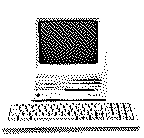

Macintosh SE/30
A Low End Mac
Best Buy
code names: Oreo, Double Stuffed, Green Jade
- Got a compact Mac? Join the Compact Macs email list.
Overview
Rolled out in January 1989, the SE/30 was the first compact Mac to come standard with the FDHD 1.4 MB floppy drive (a.k.a. SuperDrive) and support more than 4 MB of RAM. It was essentially a IIx in an SE case. Although advertised as a 32-bit computer, the SE/30 ROMs were "dirty," containing some 24-bit code, meaning it could not run 32-bit applications without new ROMs (which Apple never produced) or a software patch. To use the SE/30 in 32-bit mode, you need a free copy of Mode32 from Apple (search the page for "mode32"). (You only need 32-bit addressing if you have more than 8 MB of memory.)
The SE/30 offered the power of the IIx in a minimal footprint configuration. With the built-in 9" screen, it was a popular network server.
The SE/30 has color QuickDraw built in, so it can be used to surf the Web. However, it requires a video card, such as the discontinued Micron Xceed, to display anything beyond black and white.
-
Did you know the SE/30 could display grays on the internal monitor? If you can get your hands on the Micron Xceed video card, it supports 8-bit video on an external monitor -- or on the internal screen when no external monitor is attached. These cards are rare and highly valued.
The SE/30 can handle as large a 3.5" half-height SCSI hard drive as you can find, another reason it's long been popular as a server. To remove the hard drive: find the two screws holding the drive bracket in place. They will be facing the rear of the computer and underneath the drive itself. You'll need a fairly long Phillips screwdriver to reach them -- and you'll need to disconnect the power and data cables before you can get to them. Once the screws are loose, lift the back and it should come out easily.
There is a ROM SIMM slot on the SE/30 which must be filled with a ROM. Without this ROM, the computer will not function.
-
We've seen several claims that replacing the SE/30's ROM with a IIsi or IIfx ROM makes the SE/30 32-bit clean and allows use of Mac OS 8.1 (with a lot of fiddling). We are interested in hearing from anyone who has successfully put a IIsi or IIfx ROM into an SE/30 -- and whether you got OS 8.1 running or not. (Note that the IIsi ROM is rare; most have the ROM soldered to the motherboard.) Dan Knight , publisher.
After the SE/30, Apple didn't produce another compact Mac with an expansion slot until the Color Classic in February 1993.
You can convert a non-working compact Mac into a Macquarium. (Please, don't even think of converting a working one -- you can always find someone interested on the Classic Macs or Vintage Macs lists.)
Details
-
introduced 1989.01.19 at $4,400 ($4,900 with hard drive); discontinued 1990.10.21
-
requires system 6.0.3 to 7.5.5
-
CPU: 16 MHz 68030
-
FPU: 16 MHz 68882
-
performance: 3.2, relative to SE; 4.03, Speedometer 3.06; 0.26, Speedometer 4; 3.9 MIPS
see Benchmarks: SE/30 for more details -
ROM: 256 KB
-
RAM: 1 MB, expandable to 128 MB using two 4-SIMM banks of 120ns 30-pin memory, compatible with 256 KB, 1 MB, 4 MB, and 16 MB SIMMs (although Apple does not certify it with 16 MB SIMMs)
-
9" b&w screen, 512x342 pixels
-
ADB ports for keyboard and mouse
-
DIN-8 serial ports on back of computer
-
DB-25 SCSI connector on back of computer
-
floppy: 1.4 MB double sided
-
floppy connector on back of computer
-
size (HxWxD): 13.6" x 9.6" x 10.9"
-
weight: 19.5 lb.
-
Gestalt ID: 9
-
addressing: 24-bit or 32-bit (requires enabler)
-
battery: 3.6V lithium
-
single SE/30 PDS slot (same as IIsi)
-
upgrade path: none
Accelerators & Upgrades
-
Sonnet Allegro SE/30 (33 MHz 68030), discontinued. I have one field report that this accelerator has problems with 1.4 MB floppies, but works fine with 800 KB ones. Be sure you know your return options and test this if you buy one.
-
Daystar Turbo 040 (33 MHz, 40 MHz 68040), discontinued
-
MicroMac Diimo/030 (50 MHz 68030), 64 KB cache, optional 50 MHz 68882 FPU, pass through connector for second card
Discontinued accelerators (68030 unless otherwise noted) include the DayStar Universal PowerCache (33, 40, 50 MHz), Fusion Data TokaMac SX (25 MHz 68040), and Total Systems Magellan 040 (25 MHz 68040).
Online Resources
-
Macintosh SE Support Pages, Chris Adams
-
Macintosh SE/30 Technical Specifications, Apple Knowledge Base Archive
Cautions
-
Never connect an Apple II 5.25" floppy drive to the Mac's floppy port. Doing so can ruin the floppy controller, meaning you can't even use the internal drive any longer.
-
That monitor packs a lot of voltage. Read Compact Mac CRT Energy before working inside.
-
Macs with black-and-white only displays (1-bit, no grays) may find Netscape Navigator 3 makes it impossible to view some pages and sites. The workaround is to use Navigator 2 or 4.
-
Mode32 or Apple's 32-bit Enabler required to access more than 8 MB RAM. (Mode32 v7. works with System 7.5; Apple's enabler does not.)
-
Serial port normally restricted to 57.6 kbps; throughput with a 56k modem may be limited. See 56k modem page. For more information on Mac serial ports, read Macintosh Serial Throughput.
-
Apple discontinued support and parts orders for this model on 1998.08.31. You may be able to find dealers with parts inventory either locally or on our parts and service list.